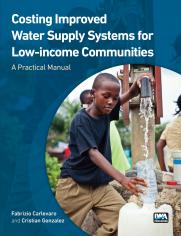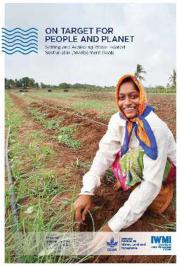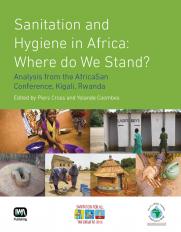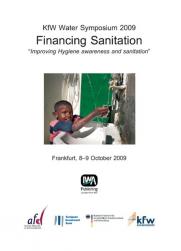Measuring Willingness-to-Pay for Water and Sanitation by People Living with HIV and AIDs in South Africa
Journal author Dr Ephias M. Makaudze outlines the significance of his studies into the importance of clean water and safe sanitation to people living with HIV and AIDs in South Africa, where rising urban slum population increasingly strains the resources of local municipalities.
 Costing Improved Water Supply Systems for Low-income Communities - Water Supply Costing Processor Tool
Costing Improved Water Supply Systems for Low-income Communities - Water Supply Costing Processor Tool
This free downloadable Excel-based costing tool is designed to be used with its manual which can be purchased...
Water-based diseases
Waterborne diseases are caused by pathogenic microorganisms which are directly transmitted when contaminated fresh water is consumed. Contaminated fresh water, used in the preparation of food, can be the source of foodborne disease through consumption of the same microorganisms. According to the World Health Organization, diarrheal disease accounts for an estimated 4.1% of the total DALY (diability-adjusted life year) global burden of disease and is responsible for the deaths of 1.8 million people every year. It was estimated that 88% of that burden is attributable to unsafe water supply, sanitation and hygiene, and is mostly concentrated in children in developing countries.
Simple Options to Remove Turbidity
The health consequences of inadequate water and sanitation services include an estimated 4 billion cases of diarrhea and 1.9 million deaths each year, mostly among young children in developing countries. Diarrheal diseases lead to decreased food intake and nutrient absorption, malnutrition, reduced resistance to infection, and impaired physical growth and cognitive development. Since 1996, a large body of published work has proven the effectiveness of interventions to improve water quality through household water treatment and safe storage (HWTS) at reducing diarrheal disease. However, not all of these interventions remove the turbidity that causes water to look dirty. Although the following options are not proven to reduce diarrheal disease incidence on their own, they can be used to pre-treat water to reduce turbidity before the use of household water treatment products. These options mechanically (through filtration) or chemically (through flocculation and settling of suspended material) remove particles and reduce turbidity. These pre-treatment methods may also increase the efficacy of household water treatment products by removing contaminants that interfere with disinfection and physical filtration processes.
Bio-toilets: Sustainable Solution to India’s Sanitation Challenge
Banka BioLoo Pvt Ltd, a firm committed to environmental betterment and social uplift, is supporting to eradicate the malaise of open defecation in India. By providing eco-friendly bio-toilets (or bioloos), the enterprise is helping meet the Millennium Development Goals (MDG-7) and actively supporting the government’s vision of an open defecation free society.
ADDIS ABABA: Sanitation Status
Sanitation provision in Addis Ababa (the capital of Ethiopia) is grossly deficient, as in most cities in sub-Saharan Africa: most people do not have access to a hygienic toilet; large amounts of faecal waste are discharged to the environment without adequate treatment; this is likely to have major impacts on infectious disease burden and quality of life (Hutton et al. 2007). This article briefly summarizes the current sanitation situation in Addis Ababa.
 On Target for People and Planet: Setting and Achieving Water-Related Sustainable Development Goals
On Target for People and Planet: Setting and Achieving Water-Related Sustainable Development Goals
eISBN: 9781789060010
IWMI scientists urge realistic targets, wise investment choices and sustainable water resources development while building resilient ecosystems. This 56-page IWMI book, illustrated with case studies and examples, provides critical analyses of how national SDG targets can be defined and met through the most current evidence-based water policies. IWMI, which recently adopted a new strategy to deliver a “water-secure world,” plans to produce a series of annual reports that synthesize thinking on major water issues.
The book contains examples of IWMI’s work in tackling complex issues, such as: - IWMI conducted pilot tests in Uzbekistan’s Ferghana Valley to “bank” winter water flows released for hydropower into underground aquifers and later extract the stored water for dry-season irrigation. Such strategies may prove to be a pragmatic way to reverse damage caused by groundwater overpumping, and to deal with competing demands for water, energy and food. - Despite today’s focus on participatory water-use management, IWMI’s research shows that women, minorities and the poor often are left out of local decision-making. In such situations, women revert to “stealing” the water they need for domestic use and crops. - Humans generate millions of tons of solid and liquid waste every day. IWMI and its partners are testing innovative, low-cost human waste-to-fertilizer models in 10 cities across the globe. Implementing such solutions is a key to achieving SDG health and environment goals in low-income countries. You can download a free copy of On Target for People and Planet: Setting and Achieving Water-Related Sustainable Development Goals here: www.iwmi.org/sdg-book If you would prefer a paper copy, please email James Clarke at j.clarke@cgair.org and we will dispatch direct to you.
 Sanitation and Hygiene in Africa: Where do We Stand?
Sanitation and Hygiene in Africa: Where do We Stand?
ISBN: 9781780405414
eISBN: 9781780405421
The Third African Sanitation and Hygiene Conference was held in Kigali, Rwanda in July 2011. It was hosted by the Government of the Republic of Rwanda, and the African Ministers Council on Water. The meeting attracted extraordinary interest: over 1000 people registered and nearly 900 people attended from a total of 67 countries, including representatives of 42 African countries. The content of AfricaSan 3 was aligned with the needs of countries as defined in country preparation meetings which took place in advance. AfricaSan 3 looked to address the country needs and to commitments and country action planning. Different groups (ministers, civil society, local government, utilities, and donors) committed to actions to support the goals of AfricaSan. The goal of the AfricaSan process is to support countries to achieve the Millennium Development Goal, (MDG) for sanitation and hygiene.
Sanitation and Hygiene in Africa: Where do We Stand? takes stock of progress made by African countries through the AfricaSan process since 2008 and the progress needed to meet the MDG on sanitation by 2015 and beyond. This book addresses priorities which have been identified by African countries as the key elements which need to be addressed in order to accelerate progress. Reviews progress on implementing the eThekwini Declaration to meet the MDG for sanitation and progress generally in Africa. It analyses what is needed to accelerate the rate of access to sanitation in Africa. Shares advances in the evidence base on sanitation and hygiene in Africa to be able to assist decision-makers to overcome key blockages in implementing large-scale sanitation and hygiene programs. Raises the profile of sanitation and hygiene as a determinant of sustainable development in order to strengthen leadership and advocacy for sustained sanitation and behavior changes. This book is essential reading for government staff from Ministries responsible for sanitation, sector stakeholders working in NGOs, CSOs and agencies with a focus on sanitation and hygiene and water and Sanitation specialists. It is also suitable for Masters courses in water and sanitation and for researchers and the donor community.
 KfW Water Symposium 2009 Financing Sanitation
KfW Water Symposium 2009 Financing Sanitation
ISBN: 9781843393603
eISBN: 9781780401515
The central objective of the International Year of Sanitation was to put the global community on track to achieve the Millennium Development Goals MDG sanitation target.However, one year later, it is still difficult to keep sanitation high on the agenda, while practical action is required to encourage demand driven and sustainable solutions. With the support of the German Ministry for Development and Cooperation and together with the European Investment Bank EIB and the French Development Agency AFD, KfW organised a two day Symposium to specifically address ways in which financing institutions can better promote the achievement of the MDG sanitation target. More than 70 experts from various backgrounds explored the challenges of sanitation and discussed ways to further develop innovative financing mechanisms for improved hygiene, sanitation and wastewater management in low-income countries.
Four thematic areas were tackled by detailed background papers, presentations and high-level open floor discussions. Session 1: Financing Change in Personal Hygiene Behaviour and Demand Creation for Sanitation Motivation. This section contains a rapid review of past experiences in developed countries and the evolution of methods used in developing countries to change hygiene and sanitation behaviors, including successes and failures. Relative costs and impacts, the role of institutional arrangements and actors, as well as approaches for linking hygiene behavior change and sanitation demand creation (so called software investments) with hardware investments are examined. Finally, considerations and opportunities for development banks and other financing agencies to become engaged in the scale-up of hygiene behavior change and sanitation demand creation approaches which have demonstrated success are presented. Session 2: Targeting the Poor with Facilities and Improved Services Motivation. The interventions that can help poor people to access sanitation goods and services are examined. The focus is on three types of interventions: the use of low-cost technologies, the use of micro-credit and the use of targeted public finance (or subsidies) to reduce the funding gap that poor people face to meet the capital and recurrent costs of sustainable sanitation. Targeted public finance, performance assessment, effectiveness, sustainability, public funding strategies and performance are analysed. Session 3: Urban Spaces – How to Provide and Finance Service to Peri-urban Areas. New approaches to meet sanitation challenges arising from absolute population growth and rapid urbanization are examined from a technical point of view. Simplified solutions and semicentralised supply and treatment systems are examined in detail and with the help of examples. Session 4: The Potential Role of Utilities in Sanitation Provision for Peri-urban Areas and Poor Target Groups. The question why sanitation service provision by local government authorities is poor is addressed. Examples of how water supply and sanitation utilities are being encouraged to support peri-urban areas and poor target groups with the provision of sanitation services are provided. The difficulties of utilities to provide piped water and sewers in a commercially viable manner is addressed. The role of local government authorities, of the regulatory framework, of education and public awareness is highlighted. A theme that appeared in all four sessions concerned the process of project design by development banks. Recommendations to improve it in order to best tackle sanitation issues were as follows: - address the entire sanitation chain - plan for all urban areas including informal housing areas and slums - ensure the sustainable operation of all sections of the sanitation chain (long-term effectiveness).